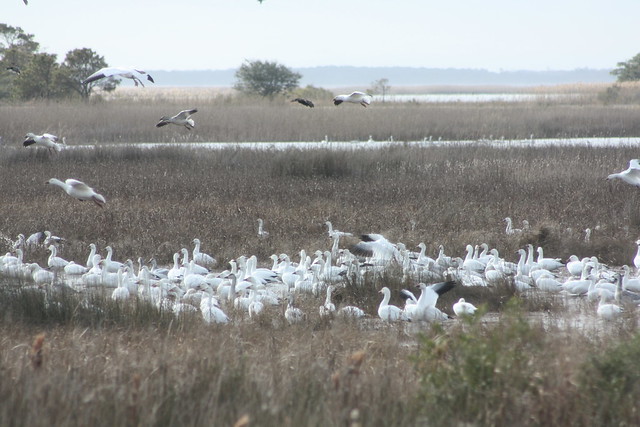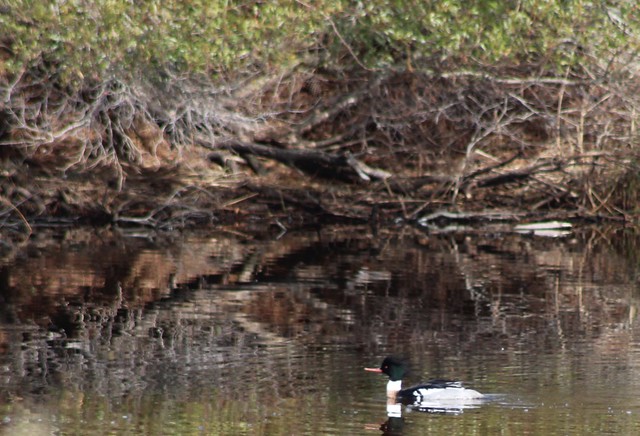Read Our Blogs
Wintering Waterfowl at False Cape
Shared by Alexa Weaver - Park Interpreter, as Guest Blogger.
There is one state park that, in conjunction with a National Wildlife Refuge, provides waterfowl protection and a quiet place to rest before they make the trip back north in the spring.
False Cape State Park is this park and is very unique and remote, located 5 miles south of Back Bay National Wildlife Refuge (NWR). Back Bay NWR was opened in 1938 with the mission of providing a refuge for waterfowl on their winter migration.

Winter visitors: Snow geese at False Cape and Back Bay NWR
Both the refuge and the state park are in a great location to complete this mission since both are on the course of the Atlantic Flyway, a heavily traveled migration route for hundreds of species of birds year-round.
After its opening, Back Bay NWR built a number of ‘impoundments’ or small bodies of water and marsh environment in between the Atlantic Ocean and Back Bay. These impoundments provide protection from hunting, plenty of food sources and a quiet place to rest, free from disturbance before the birds make the trip back north in the spring.

False Cape State Park Back Bay impoundment
The refuge goes a step further to minimize disturbances for waterfowl this time of year by closing both of their interior trails to hikers and bikers, which lead to the state park, from November 1- April 1. This, in turn, means the only way to access False Cape State Park is by hiking or biking down the beach or attending one of the park’s many tram tours.
What Species are here?
During winter migration, Back Bay NWR and False Cape State Park are a bird-watchers dream. Many species of swans, geese and ducks can be seen during the months of November to March. Among the largest and loudest species, this time of year is the Tundra Swan. Tundra Swans migrate all the way from their breeding grounds in Alaska and far northern Canada. These swans can be seen in large groups here. They have an unmistakable “hoo-ho-hoo” call that can be heard from miles away. Along with the swans, Canadian geese are commonly seen and heard throughout the refuge and park.
A variety of duck species can also be seen this time of year as well, including Gadwall, Mallard, American Black Duck, Buffleheads, Northern Shoveler, Mergansers and more. Other types of waterfowl are also commonly seen in impoundments and marshes, such as Grebes, Coots and Ibis!


How Can You See the Waterfowl?
False Cape State Park and Back Bay National Wildlife Refuge jointly hold a limited number of tram tours during the closure months from November to March in the afternoons from 12-4 p.m.. These open-aired trams can only take 24 participants and reservations are required. The Winter Tram Tours depart from Back Bay NWR and travel down the east side through the marshes and impoundments for great views of our winter visitors. On these tours, otters, eagles, deer and other wildlife are often also seen.
Once the tour enters False Cape, we make a stop at the Visitor Center and Gift Shop before heading farther south to Wash Woods to learn the history of the shipwrecks and events that gave False Cape its name.
We then take a 1 mile round trip *hike to the Wash Woods cemetery and church site from survivors of the shipwrecks in the late 1800s.
Finally, this tour travels back through Back Bay NWR on its west trail, which is also heavily populated with waterfowl, to catch some final views of these fascinating birds before the tour ends at 4 p.m.
Learn more about it here, and to make a reservation, call the Park office at (757) 426-7128. *The hike is on soft sand and not recommended for those unaccustomed to strenuous outdoor activities.
To see a listing of all upcoming events and programs at False Cape State Park, click here.
You may also enjoy:
If you have read the article and have a question, please email nancy.heltman@dcr.virginia.gov.
Search for blogs
By Park
Categories
Cabins
Camping
Fishing
History and Culture
Other
Programs and Events
Trails
Volunteers
Water Fun
Archive
2025
2024
2023
2022
2021
2020
2019
2018
2017
2016
2015
2014
2012














